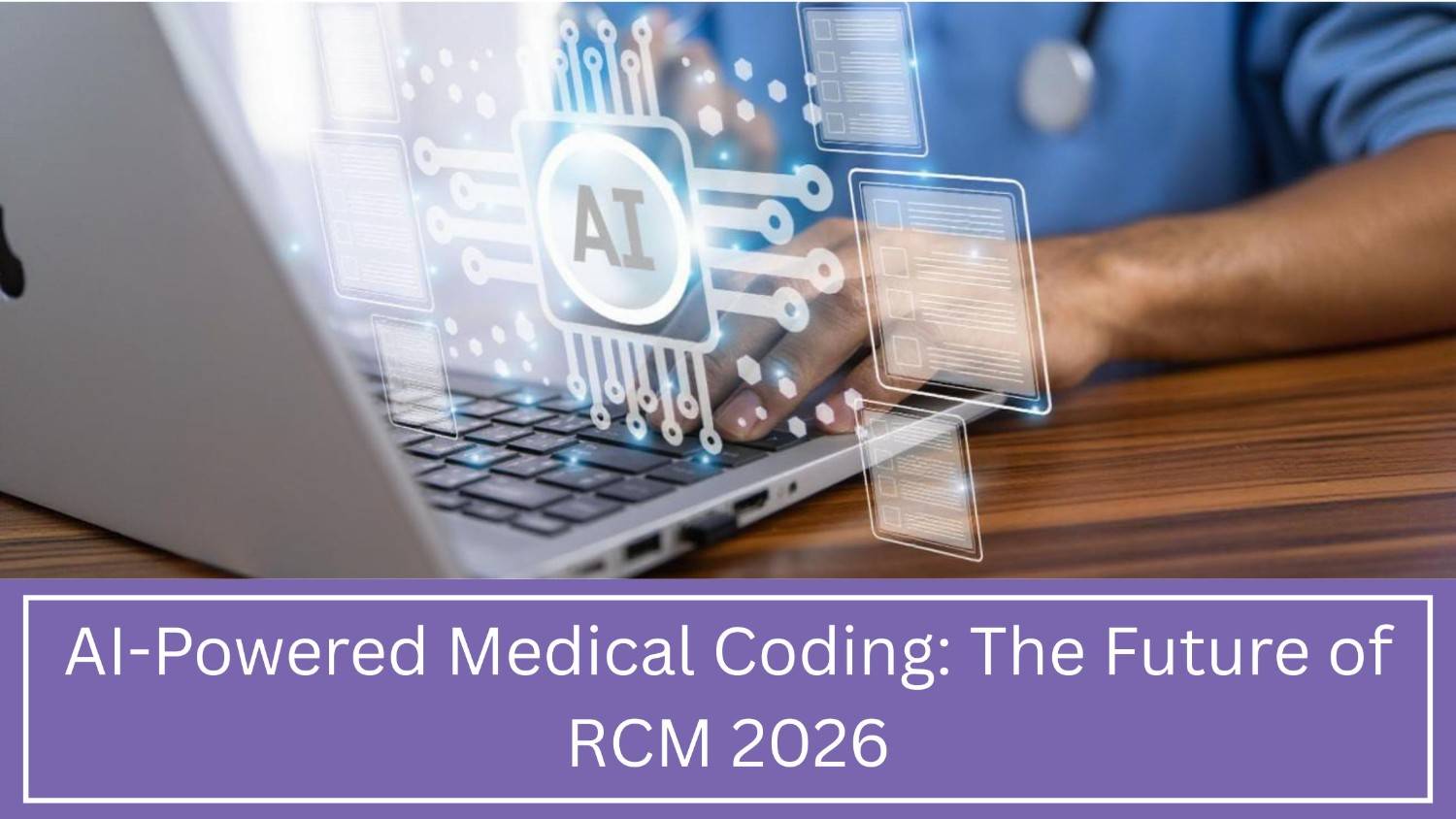AI-Powered Medical Coding: The Future of RCM 2026
AI-Powered Medical Coding: The Future of RCM 2026 — AI is transforming medical billing faster than ever. By 2026, intelligent tools will review records, assign accurate codes, and detect errors instantly, reducing denials and saving valuable time. This blog explores key trends, real data, and safe AI adoption steps. Discover how combining AI innovation with human expertise enhances coding precision, accelerates claim processing, and strengthens cash flow. Learn how to future-proof your practice by managing risks and monitoring KPIs. Practolytics reveals how AI is driving faster, smarter revenue cycle success.
Table of Contents
Future Trends: What’s Next for AI and RCM Beyond 2026
Healthcare billing is changing fast. More clinics now use AI to code claims quickly, cut errors, and speed up payments. By 2026, AI medical coding will be key for managing clinic cash flow. Here’s what your clinic needs: why it matters, how to get ready, plus trends, numbers, risks, and steps to take.
Why care?
Coding turns care into payments. Mess it up? Claims stall. Cash slows. Staff drown in rework. AI reads notes, suggests codes, and catches errors live—cutting denials, speeding cash, and saving hours. Bottom line: Smoother coding means steady money and calmer teams.
What’s new in 2025–2026: big trends and facts
AI use in healthcare revenue cycle management services jumped sharply during 2024-2025. Healthcare providers now actively plan to add AI tools for jobs like checking eligibility, coding, and handling denials. Reports show the RCM market is growing fast, with AI driving much of this growth. Experts see strong market gains through 2026.
A 2026 RCM survey shows teams aren’t just talking about AI—they’re using it now to cut costs and save time. Clinical trials prove the point: when AI tools work with coders, accuracy jumps and processing speeds up. These wins confirm our hybrid approach: AI lifting human skills higher.
How AI helps medical coding — the simple parts
Here are five ways AI upgrades coding work:
- Scans doctor notes: Finds diagnoses and treatments fast using language tech.
- Recommends codes: Suggests ICD-10/CPT codes for quick review.
- Spots gaps: Warns when notes miss key facts for correct coding.
- Learns constantly: Gets smarter when coders tweak its suggestions.
- Targets risks: Flags claims prone to denial before billing.
This cuts guesswork and speeds billing. AI handles routine work; your team tackles complex cases and rules.
A simple example of AI + human workflow
- Patient visit details go into the EHR.
- AI scans this note and proposes medical billing codes.
- A human coder checks these suggestions and approves or adjusts them.
- The final code then goes out on the claim.
- AI tracks its own accuracy, learning from corrections.
- This keeps human oversight while slashing claim processing time.
- It also reduces costly errors that trigger denials.
Real numbers and proof points
Recent pilots and studies (2024–2025) show AI tools boost coding speed and accuracy when used by trained coders. One trial proved clear gains in both time and quality.
Industry reports show growing RCM market forecasts and expanding AI adoption in billing tasks. These shifts are pushing tools that combine AI with automation into daily practice.
Key benefits for RCM teams
- Fewer denials – Cleaner coding cuts simple denials from wrong or missing codes.
- Faster claims – AI speeds coding, so claims move quickly.
- Lower cost per claim – Less manual work lowers labor costs.
- Better staff focus – Coders shift from routine tasks to high-value work like appeals and complex cases.
- Clear audit trail—AI logs every code suggestion and its reason, simplifying audits.
These benefits combine for quicker payments, less rework, steadier cash flow, and reduced stress.
How to measure success: useful KPIs
When you test AI coding, track five simple numbers:
- Claim accuracy (% correct first time)
- Time per record (minutes)
- Denial rate for coding errors (%)
- Rework hours saved weekly
- Clean claim rate (payers accept edits)
If these improve, your AI works.
Where AI still needs humans
AI is strong, but it has limits:
For tough health cases, skilled doctors must take charge.
- Rule changes: Humans decode new insurance rules and policy shifts.
- Security: People double-check that patient data stays safe.
- Rare cases: Experts handle unusual surgeries or unclear notes.
The smart move? Blend AI with human skills. This keeps quality strong while moving faster.
Handling risks
Too much trust in AI? Keep people checking. Have staff review AI work before final calls.
- Model drift: Update AI systems regularly. Retrain them with new data to maintain accuracy.
- Data security: Secure patient health information. Follow HIPAA and other privacy laws strictly.
- Bias and errors: Watch for patterns of mistakes in AI results. Correct them immediately.
- Vendor lock-in: Choose flexible tools. Use open formats and ensure easy data exports.
Start managing these risks early. A small oversight team can handle them effectively.
Practical rollout plan—start simple and prove value
- Pick one starting point: inpatient coding or outpatient procedures.
- Run a shadow test: Let AI draft codes while humans keep final say. Track differences.
- Compare outcomes: Use the KPIs for 60–90 days.
- Train your team: Show coders how to safely check AI suggestions.
- Expand carefully: If accuracy and speed improve, roll out to more claims.
- Automate workflows: Link AI outputs to claim submissions and denial handling to save hours.
This phased approach cuts risk and proves ROI fast.
Tech fit: what to look for in AI coding tools
- High-quality NLP for medical language: precise medical language understanding
- Explainable suggestions so coders see why a code was suggested: Clear reasoning behind every coding suggestion.
- Easy feedback loop so corrections train the model: quick learning from user corrections.
- Audit-ready exports: Simplify reporting with one-click data packages.
- Seamless EHR/billing sync: Connect instantly to major healthcare systems.
- Built-in compliance shields: Automate security for HIPAA and audits.
Vendor demos and short pilots help find the best fit—test-drive options to match your needs.
Industry momentum and jobs
AI will change coding jobs, not kill them. Think of it like a discus thrower: AI launches routine tasks at speed, freeing coders to solve harder puzzles. Teams must train differently—learn to check AI work, spot mistakes, and handle tricky cases. This cuts busywork and adds strategy.
Combining AI with other RCM tools
AI works best when it connects to:
- Coverage checks (to verify eligibility upfront)
- Automated denial fixes (to resolve issues quickly
- Analytics dashboards (to spot revenue trends)
- Payment tools (to collect patient payments faster)
Together, these steps streamline cash flow.
Common pitfalls?
Running AI without oversight? That’s like flying blind—you’ll drift off course immediately.
Ignoring KPI tracking? Poor choice. If you skip measuring results, you can’t prove success. How will you defend the spending?
Skipping staff training? Expect confusion. Teams must learn new methods—or they’ll cling to old ways.
Picking tools that don’t connect? Costly. Systems need to link up, or you create extra tasks.
Avoid these errors. Your project stays on target.
What leaders should plan for in 2026
- Budget for pilot tests and setup, not just software fees.
- Train coders and auditors early.
- Create a small team to monitor model results.
- Use pilots to prove value before expanding.
- Do this right: the claims process is faster, and denial costs drop.
- Leaders who act fast win cash-flow gains sooner.
Conclusion—Where Practolytics helps
AI-powered coding isn’t tomorrow’s dream—it’s your RCM team’s next smart move. But shifting gears feels smoother with a trusted guide. Practolytics combines AI coding, automated workflows, and analytics in one place. We help teams:
- Boost coding accuracy with AI tips and a clean human check.
- Reduce denials by catching errors before claims go out.
- Save staff hours through automation and smoother workflows.
- Watch clear KPIs on dashboards to show real value.
- Stay secure and compliant while upgrading RCM.
If your team wants fewer stalled claims and steadier payments, Practolytics helps you test AI coding and grow what works. Get faster claims, fewer denials, and a less-stressed billing crew. Collect smart. Serve well. Grow steady.
ALSO READ – Essential Tips for Error-Free Orthopedic Billing and Coding: Boost Your Practice’s Financial Health
Talk to Medical Billing Expert Today — Get a Free Demo Now!






